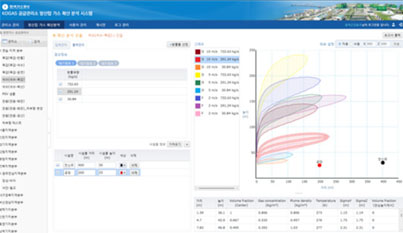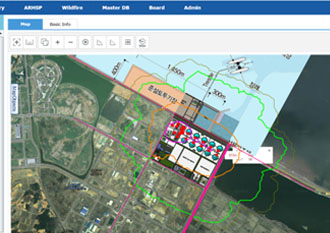KOGAS
Safety and Disaster Prevention Technology
Scientific & Advanced Safety Management, and Quantitative Risk Assessment
Quantitative risk assessment is an integrated technique that quantifies risk to maximize safety by determining the frequency and consequence of events. By developing fundamental and applied technologies to identify and quantify risk factors from initial design to full operation, KOGAS is building the nation’s most sophisticated risk management system for accident prevention. We are currently developing technologies to optimize pipe integrity and facility management by combining in-house piping systems and facility management systems.
-

Vent Stack gas dispersion analysis system
-

Fixed facility quantitative risk assessment system
Development Background
Safety is key in the heavy-duty gas equipment industry and in the operation of pipelines. Ensuring safety requires many fundamental technologies, most importantly risk assessment. However, the existing qualitative risk assessment had limitations in developing new process technology and in responding to rapid environmental changes, so in order to enhance safety, quantitative risk assessment technology was developed. Quantitative risk assessment is considered globally as typical advanced safety technology that maximizes public safety, and that simultaneously pursues industrial revitalization. This fundamental technology is therefore under continuous development.
Development Process
After the 1994 Ahyeong-dong gas explosion, a quantitative risk assessment study
was started to secure public safety. In the initial research stage, KOGAS
focused on overcoming immediate on-site safety problems by improving risk
assessment technology with overseas software. Since the mid-2000s, we have
independently developed the core technology necessary for quantitative risk
assessment, and developed a system for its use in order to advance safety
technology in the field.
Such systems include quantitative risk assessment for
fixed facilities and buried piping, and facility reliability analysis. Recently,
KOGAS has been developing integrated risk assessment technology for optimized
pipe integrity management in connection with various in-house information
systems.
Core Technology
The core technology of quantitative risk assessment for hazardous fluids is
composed of accident impact assessment and frequency analysis technology.
Accident impact assessment is based on the analysis of evaporation, expansion,
and atmospheric diffusion, applying materials’ physical properties, and also
applies analyses of fire and explosion at ignition.
Accident frequency analysis focuses on failure rate analysis, accident
probability modelling, and human
error analysis. Recently, structural reliability analysis has been studied using
mechanical limit functions and random variables. A quantitative risk analysis
system, that integrates all of these theories is the core technology that is
required for practical application.
Benefit
We are saving approximately KRW 1 billion a year in purchasing and maintaining expensive overseas programs, as we have our own fixed facility and piping risk assessment technology. In addition, considering the quantitative risk assessment of facilities and piping, diffusion analysis of diffusion towers, and forest fire impact assessment carried out by the regional divisions, significant cost savings have been achieved. These systems will greatly contribute to ensuring safety, and to reducing costs through continuous application to improve emergency response procedures on site and risk assessment in production and supply base construction and operation.


